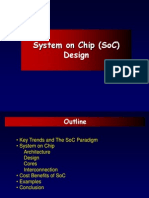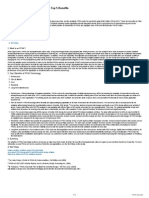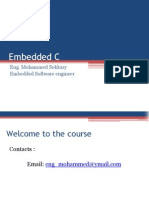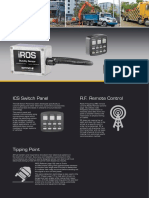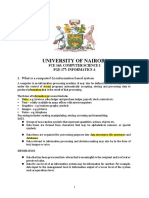Module 1. Introduction To ASIC Design
Module 1. Introduction To ASIC Design
Uploaded by
Mohammed El-AdawyCopyright:
Available Formats
Module 1. Introduction To ASIC Design
Module 1. Introduction To ASIC Design
Uploaded by
Mohammed El-AdawyOriginal Description:
Original Title
Copyright
Available Formats
Share this document
Did you find this document useful?
Is this content inappropriate?
Copyright:
Available Formats
Module 1. Introduction To ASIC Design
Module 1. Introduction To ASIC Design
Uploaded by
Mohammed El-AdawyCopyright:
Available Formats
Module 1.
Introduction to ASIC Design
Introduction to ASIC Design The semiconductor industry is different from every other industry in the world in a fundamental way. This fundamental difference presents to you, a participant in this industry, both enormous opportunities and challenges. The first part of this lesson focuses on that key difference that the underlying engine that fuels this growth increases in capability at an exponential rate. You most likely have some familiarity with the types of chips used in the semiconductor industry and the types of design and implementation styles used. The second part of this lesson starts classifying those from the sole perspective of an ASIC designer. Objectives Understand Moores Law and its impact on the semiconductor industry. Identify the defining attributes of full custom, standard cell and gate ASICs from a design and fabrication cost perspective. Identify the key steps in designing an ASIC Identify the challenges facing the semiconductor industry Key Points Exponential scaling permits fundamentally new products to be introduced on a regular cycle. ASICs are used when software is not adequate for the task from a performance or cost perspective.. Full custom ICs. Complex, expensive design, so only used for parts requiring specific circuits. They also have the highest performance. Cell based ASICs are assembled from pre-designed standard cells, using synthesis. Thus they take orders of magnitude less design effort than full custom ICs but still require a full mask set and thus take 4-8 weeks to fab. Gate array chips are built by defining just some wiring layers on already fabricated wafers containing an array of logic gates. They are designed much like cell based ICs but only a smaller mask set is required for fab, and thus take only 1-2 weeks to make. Their performance level is much lower than that of a cell based IC. FPGAs are used when the performance requirement is sufficiently low to be mapped onto an FPGA and reducing per-unit price is not imperative The major steps in the ASIC design flow are: 1. System specification 2. Logic design (RTL) 3. Logic verification 4. Physical design 5. Final verification
The Non Recurring Engineering (NRE or up-front cost) of designing a standard cell ASIC is increasing at a fast rate. The business case for this style has to be well established in order to justify the investment.
Further Reading Ciletti: Ch. 1. (Design and CAD flow) Section 8.9.1 (FPGA market) S&F: None for this section Other: EE Times www.eetimes.com Electronic Design www.electronicdesign.com Electronic Products www2.electronicproducts.com Deep Chip www.deepchip.com
You might also like
- DFT Strategy For IPsDocument11 pagesDFT Strategy For IPsumeshNo ratings yet
- Asic Interview QuestionsDocument2 pagesAsic Interview Questionspritam044No ratings yet
- System On Chip PresentationDocument70 pagesSystem On Chip Presentationshree_rs81No ratings yet
- Valeo Exam CafcDocument17 pagesValeo Exam CafcMohammed El-Adawy100% (1)
- Chapter 5: Asics vs. PldsDocument13 pagesChapter 5: Asics vs. PldsLaxmanaa GajendiranNo ratings yet
- ASICs KumarDocument47 pagesASICs Kumarmolugu kumaraswamyNo ratings yet
- ASIC1Document18 pagesASIC1basavalingaswamy2020No ratings yet
- Introduction To ASIC TechnologyDocument6 pagesIntroduction To ASIC Technologyrpa projectNo ratings yet
- ASIC Design Flow and Methodology - An OverviewDocument6 pagesASIC Design Flow and Methodology - An OverviewAhtasham KhokherNo ratings yet
- Application-Specific Integrated Circuits (ASICs)Document5 pagesApplication-Specific Integrated Circuits (ASICs)ijeteeditor100% (1)
- VLSIDocument26 pagesVLSIRamesh LakshmananNo ratings yet
- ASIC Design FlowDocument5 pagesASIC Design FlowsrinathNo ratings yet
- FPGA To ASIC CONVERSION-RPTDocument31 pagesFPGA To ASIC CONVERSION-RPTSangeeta SoniNo ratings yet
- Automotive Electronics Design Companies in Bangalore Univision Technology ConsultingDocument2 pagesAutomotive Electronics Design Companies in Bangalore Univision Technology ConsultingUnivision Technology ConsultingNo ratings yet
- ASIC Design: Prabhavathi P Associate Professor Dept. of ECE, BNMITDocument203 pagesASIC Design: Prabhavathi P Associate Professor Dept. of ECE, BNMITPrabhavathi ParameshwarappaNo ratings yet
- SocDocument49 pagesSocVarun ChauhanNo ratings yet
- The Characteristics of ASICsDocument5 pagesThe Characteristics of ASICsVLSIprojectNo ratings yet
- ASIC Design FlowDocument15 pagesASIC Design Flowraghulraghul55008No ratings yet
- Application - Specific.IC DesignFlowDocument8 pagesApplication - Specific.IC DesignFlowNandagopal SivakumarNo ratings yet
- Programmable ASIC Design: Haibo Wang ECE Department Southern Illinois University Carbondale, IL 62901Document25 pagesProgrammable ASIC Design: Haibo Wang ECE Department Southern Illinois University Carbondale, IL 62901Huzur AhmedNo ratings yet
- Asic Design FlowDocument25 pagesAsic Design FlowKarishma Potnuru100% (1)
- Deming Chen: Chapter 38, Design Automation For Microelectronics, Springer Handbook of AutomationDocument15 pagesDeming Chen: Chapter 38, Design Automation For Microelectronics, Springer Handbook of AutomationanilariNo ratings yet
- Introduction To FPGA Technology: Top 5 Benefits: 1. What Is An FPGA?Document1 pageIntroduction To FPGA Technology: Top 5 Benefits: 1. What Is An FPGA?ferdiNo ratings yet
- UNIT 5 - First HalfDocument9 pagesUNIT 5 - First Halfsvvarsha124No ratings yet
- ASIC vs. ASSP vs. SoC vs. FPGA - What's The DifferenceDocument9 pagesASIC vs. ASSP vs. SoC vs. FPGA - What's The DifferencejackNo ratings yet
- VLSI Unit-5 2marksDocument4 pagesVLSI Unit-5 2marksAnitha SNo ratings yet
- Wipro System On ChipDocument11 pagesWipro System On Chipprodip7No ratings yet
- SOC - BasicsDocument52 pagesSOC - BasicsShanmukha Pulipati100% (2)
- Fpga ArchitectureDocument98 pagesFpga ArchitectureKavya Vimal100% (1)
- Day 1Document25 pagesDay 1Abdul SatharNo ratings yet
- Chapter 5Document35 pagesChapter 5dawitdereje921No ratings yet
- uvFaNUGsbsosbBtzDocument13 pagesuvFaNUGsbsosbBtznaveensmarttttNo ratings yet
- Asic CH1Document16 pagesAsic CH1Anonymous eWMnRr70qNo ratings yet
- Issues and Strategies For The Physical Design of System-On-A-Chip AsicsDocument14 pagesIssues and Strategies For The Physical Design of System-On-A-Chip Asicskryptonites1234No ratings yet
- FPGAs - CHRONOLOGICAL DEVELOPMENTS AND CHALLENGESDocument13 pagesFPGAs - CHRONOLOGICAL DEVELOPMENTS AND CHALLENGESIAEME PublicationNo ratings yet
- ASIC Cell LibrariesDocument2 pagesASIC Cell Librariesrpa projectNo ratings yet
- System On Chip (Soc) DesignDocument70 pagesSystem On Chip (Soc) DesignspaulsNo ratings yet
- ASIC Design Classification DetailsDocument27 pagesASIC Design Classification Detailsnaveenchand_a6No ratings yet
- Project CHDocument14 pagesProject CHPauliniNo ratings yet
- Vlsi Design 21Document226 pagesVlsi Design 21amanuel abrehaNo ratings yet
- unit 5-1Document45 pagesunit 5-1afrideemohammedNo ratings yet
- DEE6113 Topic 6Document78 pagesDEE6113 Topic 6Magesh Waran GanesanNo ratings yet
- VHDL NotesDocument40 pagesVHDL Notesangel_hunNo ratings yet
- UntitledDocument4 pagesUntitled291SWAYAM BEHERANo ratings yet
- Introduction 07 23Document83 pagesIntroduction 07 23yhossam95No ratings yet
- System On ChipDocument12 pagesSystem On Chipimcoolsha999No ratings yet
- WINSEM2019-20 ECE5014 ETH VL2019205005781 Reference Material I 20-Dec-2019 Types of ASICDocument50 pagesWINSEM2019-20 ECE5014 ETH VL2019205005781 Reference Material I 20-Dec-2019 Types of ASICAashishNo ratings yet
- Embedded Systems Unit I Part A (2 Marks)Document47 pagesEmbedded Systems Unit I Part A (2 Marks)Vijaya KumarNo ratings yet
- Paper SoftcoresDocument8 pagesPaper SoftcoreslegendarykxNo ratings yet
- CSE Lec2Document73 pagesCSE Lec2tranlenguyen.workNo ratings yet
- Lecture 4Document40 pagesLecture 4Mustjab HussainNo ratings yet
- 61a5936b401659 12738204Document5 pages61a5936b401659 12738204sanjana.nijankodNo ratings yet
- Introduction To Field Programmable Gate Arrays AND Its ApplicationsDocument13 pagesIntroduction To Field Programmable Gate Arrays AND Its ApplicationsParidhi NagoriNo ratings yet
- Anmol MergedDocument47 pagesAnmol MergedROUGH X YTNo ratings yet
- Unit 1Document50 pagesUnit 1mohitNo ratings yet
- Why Take 6.375: 6.375: Complex Digital SystemsDocument14 pagesWhy Take 6.375: 6.375: Complex Digital SystemsIslam SamirNo ratings yet
- System On ChipDocument11 pagesSystem On ChipAnonymous 4fXluvNo ratings yet
- FPGA Programming for Beginners: Bring your ideas to life by creating hardware designs and electronic circuits with SystemVerilogFrom EverandFPGA Programming for Beginners: Bring your ideas to life by creating hardware designs and electronic circuits with SystemVerilogNo ratings yet
- Engineering the CMOS Library: Enhancing Digital Design Kits for Competitive SiliconFrom EverandEngineering the CMOS Library: Enhancing Digital Design Kits for Competitive SiliconRating: 1 out of 5 stars1/5 (1)
- Xilinx Tutorial Spartan3 Home PCDocument50 pagesXilinx Tutorial Spartan3 Home PCCruise_IceNo ratings yet
- Final NEO 16Document49 pagesFinal NEO 16Shiva Bhasker ReddyNo ratings yet
- Eetop - CN FPR 10 1.labDocument162 pagesEetop - CN FPR 10 1.labMohammed El-AdawyNo ratings yet
- Uvm Users Guide 1.1Document198 pagesUvm Users Guide 1.1boojahNo ratings yet
- Color Slides SOCE 3 3Document184 pagesColor Slides SOCE 3 3Mohammed El-AdawyNo ratings yet
- Introduction To ASIC Design: Dr. Paul D. Franzon Genreal OutlineDocument54 pagesIntroduction To ASIC Design: Dr. Paul D. Franzon Genreal OutlineMohammed El-AdawyNo ratings yet
- ELC609F12 Lec0 IntroductionDocument16 pagesELC609F12 Lec0 IntroductionMohammed El-AdawyNo ratings yet
- ECE465 Lecture Notes # 11 Clocking Methodologies: Shantanu Dutt UICDocument21 pagesECE465 Lecture Notes # 11 Clocking Methodologies: Shantanu Dutt UICMohammed El-AdawyNo ratings yet
- Timing PathsDocument44 pagesTiming PathsMohammed El-Adawy100% (2)
- Embedded CDocument111 pagesEmbedded CMohammed El-Adawy100% (7)
- Chapter 13-Processes For Electronic ProductsDocument62 pagesChapter 13-Processes For Electronic ProductsJann Paulo MendozaNo ratings yet
- ACCENTURE Placement PaperDocument10 pagesACCENTURE Placement PaperTiwari AnuragNo ratings yet
- Synopsys VCS IP Block Verification Ieee 1149-1-2013Document2 pagesSynopsys VCS IP Block Verification Ieee 1149-1-2013Ki KiNo ratings yet
- Building The N8VEM For The Total Beginner v1.1Document20 pagesBuilding The N8VEM For The Total Beginner v1.1Yoni Ganas DestoNo ratings yet
- CoDocument61 pagesCoRohit SrivastavNo ratings yet
- Nokia 1830 DWDM Product OverviewDocument23 pagesNokia 1830 DWDM Product OverviewRodagom MogNo ratings yet
- Module 1 - Introduction To ICTDocument17 pagesModule 1 - Introduction To ICTciapadlanNo ratings yet
- Embedded System Components: Microcontroller and Embedded Systems Notes (18Cs44)Document66 pagesEmbedded System Components: Microcontroller and Embedded Systems Notes (18Cs44)Reality Show UpdatesNo ratings yet
- sr20 Switchingsystems080222Document20 pagessr20 Switchingsystems080222Daniel BholahNo ratings yet
- L1-OVERVIEW OF COMPUTERS 165 177 Computer ScienceDocument16 pagesL1-OVERVIEW OF COMPUTERS 165 177 Computer ScienceBetty Njeri MbuguaNo ratings yet
- C4 - Kulicke and Soffa Industries, Inc. Designing A Supply Chain NetworkDocument14 pagesC4 - Kulicke and Soffa Industries, Inc. Designing A Supply Chain NetworkxczcNo ratings yet
- A Natively Flexible 32-Bit Arm Microprocessor - NatureDocument1 pageA Natively Flexible 32-Bit Arm Microprocessor - Natureقرأت لكNo ratings yet
- Ta 8403 KDocument5 pagesTa 8403 KFlorenz RemasteredNo ratings yet
- Schneider Electric Introduces First ePAC, Combines PAC With Ethernet BackboneDocument19 pagesSchneider Electric Introduces First ePAC, Combines PAC With Ethernet BackboneAnonymous ggRTHDKe6No ratings yet
- 4 Biochip Implant SystemDocument27 pages4 Biochip Implant SystemAnonymous WFKwtSaoNo ratings yet
- Iphone Tristar (U2) ReplacementDocument5 pagesIphone Tristar (U2) ReplacementJoséCarlosLeme100% (1)
- Blockchain Education Report 1Document32 pagesBlockchain Education Report 1iguestzNo ratings yet
- AEC Q100 Rev G Base DocumentDocument36 pagesAEC Q100 Rev G Base DocumentAmelyn Canillas100% (1)
- ATV Application Guide 2012 BRDocument64 pagesATV Application Guide 2012 BRKongala Vamsi KrishnaNo ratings yet
- Assignment 1 Generations of ComputersDocument8 pagesAssignment 1 Generations of Computersmalikabuzarnaeem416No ratings yet
- Embedded Systems Model Paper PDFDocument4 pagesEmbedded Systems Model Paper PDFසම්පත් චන්ද්රරත්නNo ratings yet
- Why Take 6.375: 6.375: Complex Digital SystemsDocument14 pagesWhy Take 6.375: 6.375: Complex Digital SystemsIslam SamirNo ratings yet
- Smart Dust Full ReportDocument26 pagesSmart Dust Full ReportRavinder KumarNo ratings yet
- Geerations of Computer 1st To 5th Explained With PicturesDocument9 pagesGeerations of Computer 1st To 5th Explained With PicturesTamirat DheressaaNo ratings yet
- Embedded Systems Design: A Unified Hardware/Software IntroductionDocument38 pagesEmbedded Systems Design: A Unified Hardware/Software Introductionopenid_ZufDFRTuNo ratings yet
- CO101 Lec01 IntroductiontoComputerSystemsOrganizationDocument18 pagesCO101 Lec01 IntroductiontoComputerSystemsOrganizationNightcore WitchNo ratings yet
- Low Power Design LimitsDocument10 pagesLow Power Design LimitsMy NameNo ratings yet
- Ge Elec ReviewerDocument4 pagesGe Elec ReviewerYou NichNo ratings yet
- Extreme Ultraviolet Lithography Seminar TopicsDocument25 pagesExtreme Ultraviolet Lithography Seminar TopicsMubashir Ibn alfaNo ratings yet


